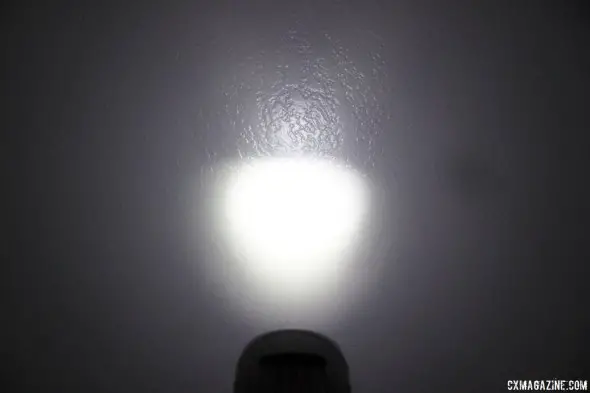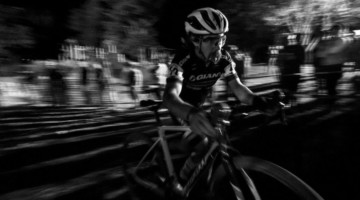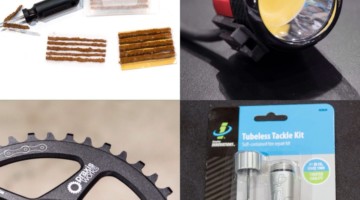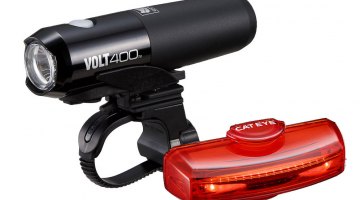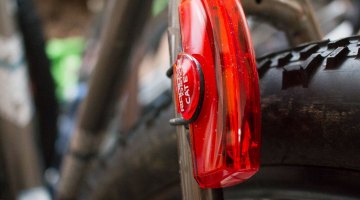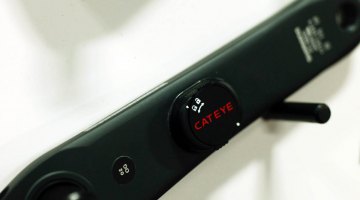With the dark evenings following the end of Daylight Savings, we’re trying to bring the light back into your cyclocross training with some night riding tips and ongoing light reviews. If you haven’t seen them yet, also see our guidelines on what to look for in a bike light for cyclocross training and some night riding tips.
CatEye Nano Shot Plus LED Bicycle Headlight
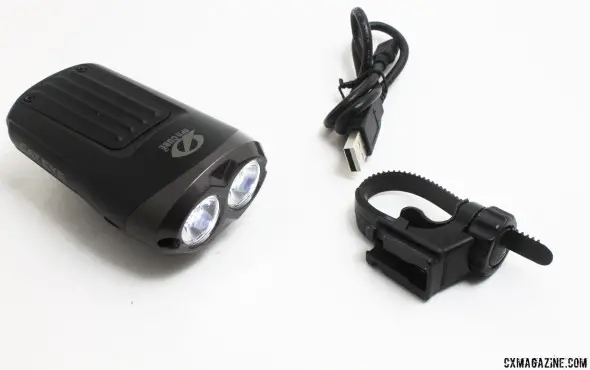
Charging cable, headlight and versatile mount included with the CatEye Nano Shot Plus LED bike light. © Cyclocross Magazine
If you’ve been around bikes for not just years but decades, you can be forgiven if you hear the name CatEye and think of small, affordable bike computers and alkaline battery halogen commuter lights hanging on your bike shop’s wall that can be had for $20 bucks. Yes, CatEye built its name and bike shop presence with those types of items, and the company still has affordable computers and lights, but while you moved from friction-shifting to DoubleTap or STI levers, the Japanese company has evolved as well.
CatEye has long been an innovator in bicycle electronics, having introduced the first flashing bike head lamp in 1964 (no, we don’t remember that), and the first bicycle white LED headlamp in 2001. Between those milestones, the company also introduced its first cycle computer (“cyclocomputer”) in 1981, the iPhone-sized CC-1000 (seen here). The company has recently gone to battle Garmin in the GPS market, with its Stealth 500 GPS cycling computer that we recently reviewed in July, and even has a novel helmet-mounted Inou GPS-enabled camera that we first previewed at Interbike 2011.
CatEye currently offers no less than 13 headlights, with its blinding three-beam 24-hour mountain bike race-worthy $325 Sumo 3 headlamp system that produces 5500 candlepower, down to its affordable Opticube light line that works on AA or AAA batteries.
Recently we’ve been testing two cyclocross- and trail-worthy lights from CatEye in the form of the new CatEye Volt 1200 headlight and the older Nano Shot+ headlight. Both lights are self-contained, Lithium Ion rechargeable lights with two LEDs, but there are plenty of differences between the two. The company also recent released the Volt 300, a single LED light that can easily be helmet-mounted.
The newer Volt 1200, compared to the older Nano Shot+, has double the rated light power (1200 versus 600 lumens), more than double the battery capacity (6200mAh vs 2800mAh), more steady and flashing modes, a much longer maximum burn time, and a micro USB charging port instead of a mini USB port. Our review on the Volt 1200 is coming shortly.
Nano Shot Plus – Focusing the Lumens
If you’re looking for a no-nonsense light to last for an hour-long cyclocross practice (and a little riding to and from practice), the Nano Shot Plus is quite a capable light. It’s plenty bright enough to be seen, to light up the road or trail in complete darkness, and highlight the area in front of you on a cyclocross course.
As we emphasized in our cyclocross bike light buying tips, selecting a light is more that just looking at the advertised lumens. Finding the right light for your needs has a lot to do with beam pattern and how that light is focused.
The Nano Shot Plus’ beam is focused into a triangular shape, sort of like a squashed yield traffic sign, and the flat, cut-off top of the beam keeps you from wasting energy lighting up the sky and avoids blinding drivers, while it narrows a bit as you get closer to the bike. It’s a better shape than the typical round pattern found on many lights, especially one LED versions.
When mounted on a handlebar, the pattern is a bit narrow for great peripheral viewing, which would be needed for fast trail riding, but on a typical cyclocross course that’s more open and has less obstacles, it’s an effective beam to keep you riding fast and safely.
Construction is top-notch, typical of what you would expect a made-in-Japan product would be, and well-sealed to keep out the elements. In attempt to keep weight (and cost) low, it’s still mostly plastic with a small metal heat sink at the top of the light for cooling.
Operation is simple with just one button on the back of the light. Hold it down, and the light turns on. Pressing it again quickly cycles through either the high or low modes, while double clicking it turns on the flashing “Hyper” mode. The light is smart in that it remembers the mode you were in last when you turn it back on, but its memory only applies to the steady mode options, not the flashing mode. That inconsistency makes it less intuitive than if it remembered any mode, or if it always behaved the same way when being turned back on.
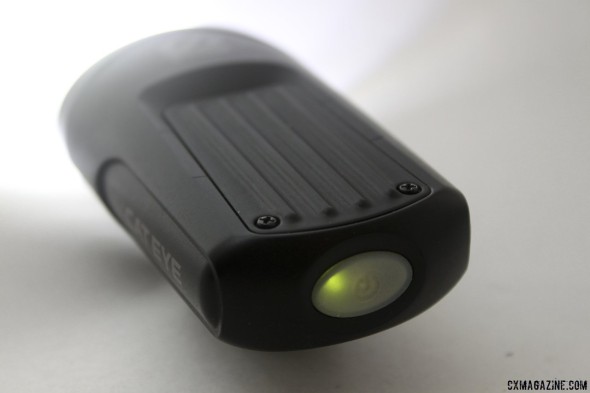
On/Off button turns from green to red when it needs a new charge. CatEye Nano Shot Plus LED bike light. © Cyclocross Magazine
The on/off switch will let you know when the battery is low by turning red. It also will indicate charging or battery problems. Note: The Nano Shot+ definitely prefers a high capacity charger. Plugging it into an ancient phone charger resulted in a flashing yellow light, meaning it wasn’t being charged. You’re better off with a more modern USB charger anyway, for faster charge times.
CatEye has held firm to its standard “hold anything” computer/light mount, and these lights, along with almost any other CatEye product, will snap right into existing CatEye mounts. The plastic thumbscrew takes just 20 seconds to mount to a handlebar, and was easy to swap between bikes. Since it’s tool-less, you have to make sure you tighten it down with some effort, especially when riding over bumpy terrain, to keep the light stable, but it’s a quick, convenient mount that’s more stable than the increasingly common rubber-band mounts. (Lights snap into mounts from front-to-back, so that in case you hit an obstacle like a tree branch while moving forward, your investment doesn’t pop off the mount.)
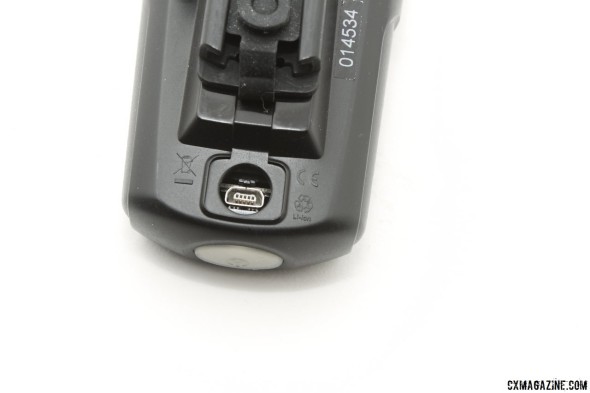
Mini USB charging port and CatEye’s standard mount on the Nano Shot Plus LED bike light. © Cyclocross Magazine
There’s a few things to nitpick with this light, and the biggest is that the flashing “Hyper” mode (typically used by commuters to be seen) doesn’t last very long at only two hours. That means you’re recharging quite often if you’ve got a decent commute, and you’re limited should you aim to get some hours in the saddle at night.
It also lacks any side visibility, meaning that all lens elements are pointed forward and cannot be seen at a side angle. That’s an efficient way of harness all power to light your way, but for cars, animals and other riders who may be approaching you at a right angle, the light doesn’t help you remain visible.
Lastly, the mini USB port is a bit outdated, when most cell phones and devices have moved to the micro USB port. Thankfully, CatEye’s newer Volt 300 and Volt 1200 lights have gone that direction as well. The mini USB port doesn’t make charging any more difficult, but requires remembering to bring the charging cable even if you’re surrounded by micro USB chargers at work and need your light that night for a commute or for cyclocross practice.
At just 166g and $120, the Nano Shot Plus does well in the lumens-per-dollar and lumens-per-gram metrics when compared against other brand name lights that come with warranties. Speaking of warranties, CatEye’s is two years, but does not cover normal battery deterioration. You can expect to get 300 charges on this battery before it significantly deteriorates.
The CatEye Nano Shot Plus is a fine light for everything but your technical mountain bike adventures or endurance night rides. CatEye just launched the $200 Volt 1200 with double the brightness and more features. Will that be a better cyclocross light? Stay tuned as we bring you more light reviews from in the next few days.
CatEye Nano Shot Plus LED Bicycle Headlight Specs:
MSRP: $120
Weight: 166g
Lumens: 600
LEDs: 2 high intensity white
Full power burn time: 1.5 hours
Maximum burn time: 4 hours (low)
Flashing burn time: 2 hours
Different light modes: 3
Charge time: 8 hours (USB 2.0)
Charging port: Mini USB
Included: USB cable, handlebar mount
More info: CatEye.com













